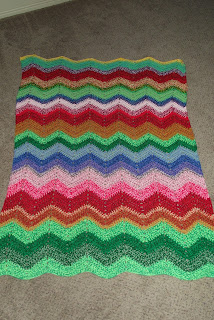 The first step to making a crochet rag rug is making your rag yarn. My favorite things to turn into rag yarn are sheets and pillow cases because they are cotton, they don't stretch, they come in all sorts of different colors and patterns, and you can find them cheap at thrift shops and yard sales! You could also use fabric scraps from sewing projects, or old t-shirts if you don't mind the stretchiness. Heavier fabrics like denim can be used, but will need to cut thinner and are a bit more difficult to work with (because they are heavier and thicker.) Choose a color scheme, hit the thrift shop, and stock up! Don't be afraid to mix patterns, because you won't likely be able to distinguish the patterns very easily once the fabric is in rug form. I just bought new pillow cases, so my source material for this demonstration will be all the random cases that I would have otherwise thrown away.
The first step to making a crochet rag rug is making your rag yarn. My favorite things to turn into rag yarn are sheets and pillow cases because they are cotton, they don't stretch, they come in all sorts of different colors and patterns, and you can find them cheap at thrift shops and yard sales! You could also use fabric scraps from sewing projects, or old t-shirts if you don't mind the stretchiness. Heavier fabrics like denim can be used, but will need to cut thinner and are a bit more difficult to work with (because they are heavier and thicker.) Choose a color scheme, hit the thrift shop, and stock up! Don't be afraid to mix patterns, because you won't likely be able to distinguish the patterns very easily once the fabric is in rug form. I just bought new pillow cases, so my source material for this demonstration will be all the random cases that I would have otherwise thrown away. Once your source materials are gathered, cut or tear into strips about 3/4 to 1 inch wide. I like to use pinking shears so there is less fraying and fewer strings to deal with.
Once your source materials are gathered, cut or tear into strips about 3/4 to 1 inch wide. I like to use pinking shears so there is less fraying and fewer strings to deal with.

Once you've got a pile of fabric strips you can get started sticking them together. There are a couple different ways that I know of to do this.
The first method is to sew the strips together, end to end to form your yarn. This will give you a cleaner look, but is more time consuming. Besides, I like a rustic look for my rag rugs, so I use the second method:
Cut a slit in the end of each strip.
Pass the end of one strip through the slit in the other, then pass the long end of the first strip through it's own slit.
Pass the end of one strip through the slit in the other, then pass the long end of the first strip through it's own slit.
This will make little slipknots, which are easier to work with while crocheting than if you had just tied the ends together, making big bulky knots.
I'm sure that there are other ways of doing it, but I have yet to figure them out. So, these are the methods I go with!
 Wind your rag yarn into a ball as you add more strips, that way you won't end up with a huge tangle. Once you have a goodly sized ball, it's time to begin. I tend to make my fabric rugs into small round rugs, but there are all sorts of shapes and sizes you can make.
Wind your rag yarn into a ball as you add more strips, that way you won't end up with a huge tangle. Once you have a goodly sized ball, it's time to begin. I tend to make my fabric rugs into small round rugs, but there are all sorts of shapes and sizes you can make.
I've started a rectangular rug with the rag yarn I made for this post. In addition to circles and rectangles I've seen squares, ovals, hearts, and all sorts of different patterns and combinations. I found a few easy patterns online to give you some inspiration, and some guidance. I'm not a good pattern writer, so I found some folks who were!
If you need a bit more help with the attachment of the strips, here is a video that shows the method a bit clearer. Skip right to 5:08 for instructions on making rag yarn.
 Wind your rag yarn into a ball as you add more strips, that way you won't end up with a huge tangle. Once you have a goodly sized ball, it's time to begin. I tend to make my fabric rugs into small round rugs, but there are all sorts of shapes and sizes you can make.
Wind your rag yarn into a ball as you add more strips, that way you won't end up with a huge tangle. Once you have a goodly sized ball, it's time to begin. I tend to make my fabric rugs into small round rugs, but there are all sorts of shapes and sizes you can make.I've started a rectangular rug with the rag yarn I made for this post. In addition to circles and rectangles I've seen squares, ovals, hearts, and all sorts of different patterns and combinations. I found a few easy patterns online to give you some inspiration, and some guidance. I'm not a good pattern writer, so I found some folks who were!













































